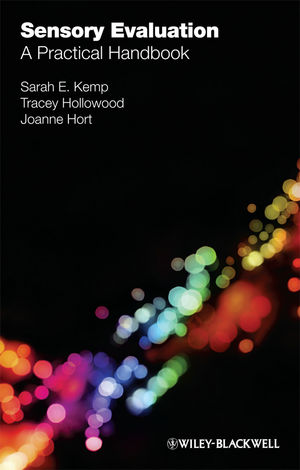Sensory Evaluation: A Practical HandbookISBN: 978-1-4051-6210-4
Paperback
208 pages
May 2009, Wiley-Blackwell
 |
||||||
Author biographies ix
Acknowledgements xi
1 Introduction 1
1.1 What is sensory evaluation? 1
1.2 What is the role of sensory evaluation? 2
1.3 What drives successful sensory testing? 3
2 Sensory perception 4
2.1 The human senses 4
2.2 Factors affecting sensory measurements 6
3 Planning your sensory project 11
3.1 Setting objectives 11
3.2 Product type 11
3.3 Budget 12
3.4 Timings 12
3.5 Selecting the test method 12
3.6 Setting action standards 13
3.7 Experimental design 14
3.8 Data analysis 19
4 Requirements for sensory testing 30
4.1 Professional conduct in sensory testing: health, safety, ethical and legal considerations 30
4.2 Good working and laboratory practices 37
4.3 Resources needed for sensory testing 41
4.4 Samples 49
4.5 Assessors 54
4.6 Data capture 63
5 Sensory test methods 66
5.1 Selecting the test 66
5.2 Discrimination tests 66
5.3 Descriptive analysis tests 96
5.4 Affective/consumer tests 118
5.5 Linking consumer, sensory and product data 136
6 Completing the project 138
6.1 Reporting 138
6.2 Documentation and data storage 140
6.3 Dos and don’ts 141
7 Appendices 142
Appendix 1: Examples of Latin Square and Williams Latin Square designs for selected number of samples 142
Appendix 2: IFST PFSG professional code of conduct for sensory professionals 143
Appendix 3: Critical values table for triangle test 147
Appendix 4: Critical values table for duo-trio test and paired comparison test for difference (one tailed) 149
Appendix 5: ANOVA explained 151
Appendix 6: Critical values table for chi-squared 156
Appendix 7: Critical values table for paired comparison and paired difference test (two tailed) 157
Appendix 8: Critical values table for Friedman test 159
Appendix 9: Types of scales 160
Appendix 10: Case study: modified quantitative descriptive analysis of chocolate texture 163
Appendix 11: R index explained 174
8 Glossary 178
9 References 185
Index 189



